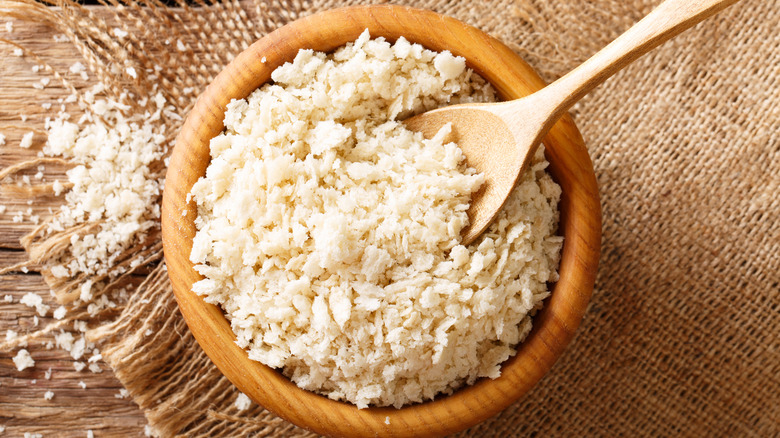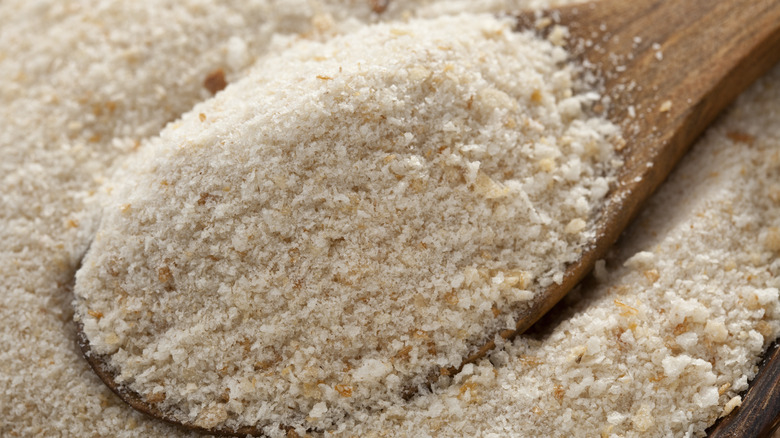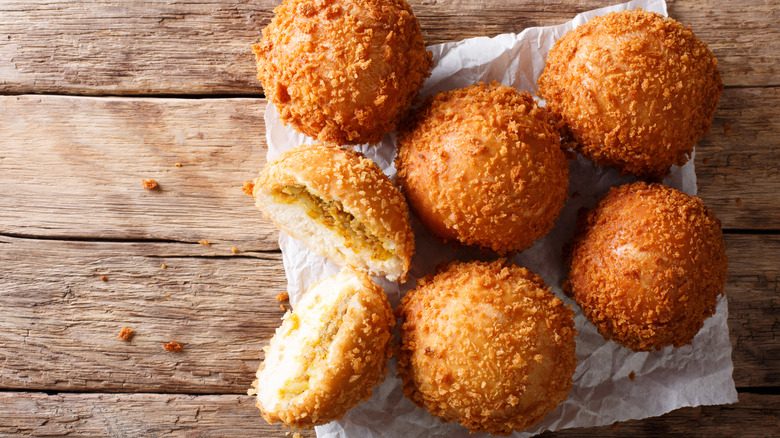Breadcrumbs And Panko Are Actually Not Interchangeable
You're whisking some eggs, a bowl of flour is laid out on the table, and all you need is some panko to dredge chicken in to make your crispy katsu dinner. But, that's when you realize you're all out of panko. Maybe all's not lost — there's still that bag of bread that you could toss in the food processor and turn into homemade breadcrumbs.
We're sorry to break it to you, but panko and breadcrumbs aren't just different names for the same coarse powder of blitzed bread, and they're not exactly interchangeable.
Panko is often perceived as an Asian-style version of breadcrumbs used for airy Japanese tempura and crisp tonkatsu, but there are several differences between the two. For one, panko and breadcrumbs are made from different kinds of breads using very different methods, which in turn also affects the texture of each. Breadcrumbs tend to be finer even if they are coarsely blitzed at home, whereas panko has a distinct flaky texture. The difference in texture is also what makes the two so different to cook with, and what could make your otherwise crisp chicken katsu soggy and greasy if you were to swap in breadcrumbs.
Two different breads set the two apart
Breadcrumbs are essentially blitzed crumbs of any bread, crust included — rye, sourdough, whole wheat, you name it — and the process to make them is as simple as grinding the slices in a food processor at home. Panko, on the other hand, is only made from white bread. But that doesn't mean that you could grind any ol' white bread into a powder and call it panko; the bread used to make it is baked using electric current in a specific oven so that it doesn't have a crust at all. The result is then air-dried, ground into small flakes, and baked in an oven till the crumbs are soft, airy, and fluffy.
Depending on whether the bread is dried before being ground and baked, there can be three types of panko: dried, semi-dried, and raw or nama, the latter of which is especially known to give a fluffier coating and a more feathery crunchiness to fried foods. The crustless white bread used to make most varieties of panko gives it a more even color compared to that of breadcrumbs, but it does lack the caramelized notes of the crust that breadcrumbs are made from.
Panko keeps food crisp for longer than breadcrumbs
The way that panko and breadcrumbs are made, and the texture of each, has a noticeable effect on the food they coat, especially when fried. For one, panko is packed more loosely than dense breadcrumbs and has an airier texture. This not only makes fried foods coated in panko more crisp and crunchy, but they also stay that way for a longer period of time than if they were coated in breadcrumbs.
Panko also absorbs less oil than breadcrumbs, which is why fried foods coated in this ingredient have a lighter outer layer — take delicate tempura, for example. Lesser oil absorption means that foods coated in panko will have a less greasy texture than those covered in breadcrumbs. Additionally, panko gives fried food the same crisp coating as breadcrumbs — if not better — in lower quantities, which essentially means that the coarse bread flakes will not be too overpowering on the tongue and will be lighter than breadcrumb-coated foods on the stomach.
If your recipe specifically calls for the use of panko and not breadcrumbs or vice versa, it may be wise to stick to it unless you want a change in texture.



